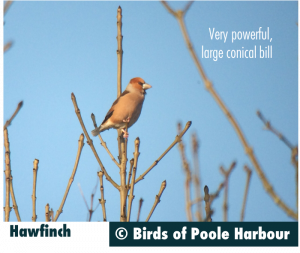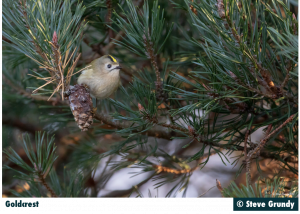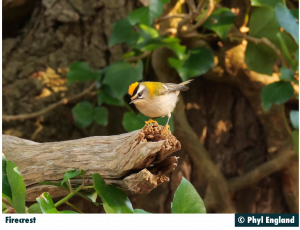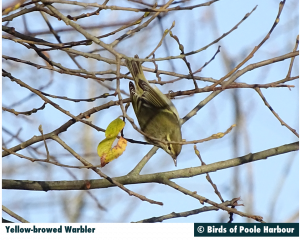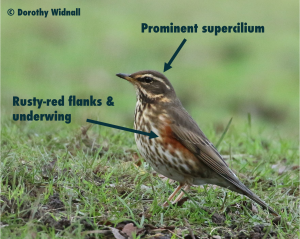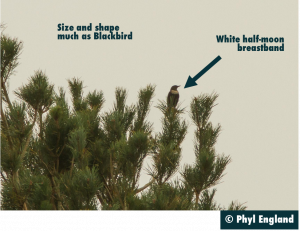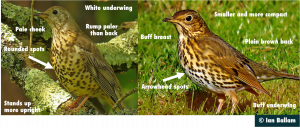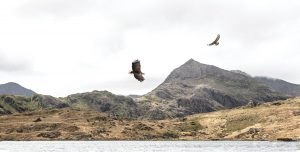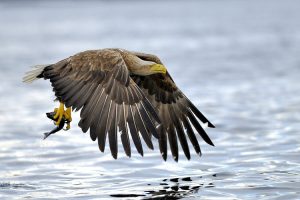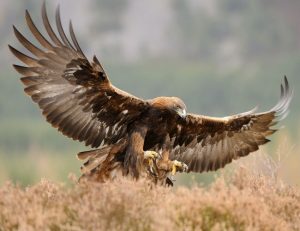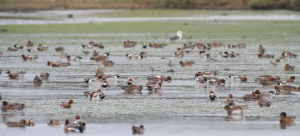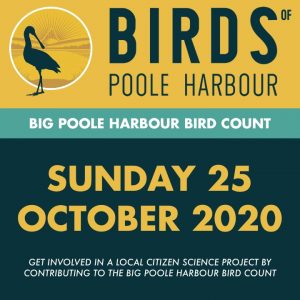Understanding where and when to ‘bird’ Poole Harbour is vital when looking to connect with the impressive finch movements that take place in October and November. While many species migrate at night, finches get moving at first light. The early risers form large flocks, travelling along invisible migration corridors during the first few hours of the day. Early morning visits to top visual migration (or ‘vis-mig’) sites such as South Haven, Ballard and Glebelands are the most rewarding.
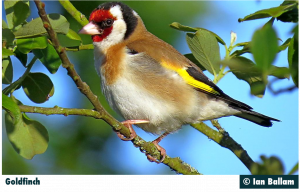
Let’s start by looking at one of our most familiar garden visitors. Goldfinch are now one of the most common visitors to our urban and rural gardens across the harbour. It’s pretty much expected that any garden feeder offering sunflower hearts will attract Goldfinch. But beyond the boundaries of our gardens, the musical twitterings of these familiar finches are readily encountered during October and November when thousands can pass over on migration in a single morning! Local parks and gardens offer a great opportunity to familiarise yourself with their cheery calls before venturing out vis-migging.
In this sound recording of a mixed finch flock at Hartland Moor in 2014, note the musical notes of the Goldfinch interspersed among the drier, lower pitched calls of the Linnet. The first half of the recording is dominated by Linnet calls, switching to Goldfinch after c.30seconds. Notice the greater variation in pitch of the Goldfinch calls, making for a delightfully ‘bouncy’ quality.
Linnet are a splendid finch of our heaths, scrub and farmland. Although a common resident, breeding is not as evident in Poole Harbour compared to only 10-15 years ago. Singing birds can still be encountered throughout the summer at Arne, Holton Lee, Canford Heath, Studland, Godlingston and Upton Heath. Whilst on passage, large numbers pass over our coastline, with impressive counts of 700+ logged in a matter of hours from first light over Ballard Down or South Haven during mid to late October. Listen out for the lower pitched flight calls, often delivered in pairs. Winter feeding flocks can occur where farmers’ fields have been left.
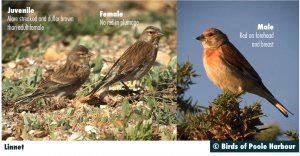
Closely resembling Linnet, the hardier Twite typically migrate from late October into early November, with most wintering further northeast. As a result, they are extremely rare in Poole Harbour, however the occasional bird could easily be overlooked. Twite are most likely to be encountered as a passage migrant in late autumn at Ballard, Glebelands or South Haven. However, there are a few over-wintering records, so it’s well worth scanning through winter Linnet flocks for the chance to pick out the gorgeous pink rump of a male Twite.
Siskin and Greenfinch can also be encountered visiting artificial feeders, along with their golden counterparts. The chunkier Greenfinch are predominantly unstreaked green in most plumages, while the smaller Siskin it differs in being strongly streaked, with boldly barred wings. Greenfinch are evident as a breeding species across the harbour, despite a slight decline in recent years due to the outbreak of Trichomonosis (find out more about the disease in this BTO article). Winter flocks do occur, but passage is much more evident in October and November, with birds passing over on migration in good numbers, although numbers have fallen. Almost merging into a trill, the rapid-fire ‘jupp‘ calls of the Greenfinch are delivered in fast bursts. The ever-increasing breeding status of Siskin has resulted in the species becoming far easier to locate in the harbour. Winter sees adults bringing their young to our niger seed feeders around the harbour, however large flocks of 500+ strong can be counted on passage during the autumn as birds pass the harbour mouth early morning. Listen out for the diagnostic, ringing ‘tilu’ calls.
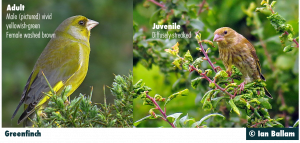
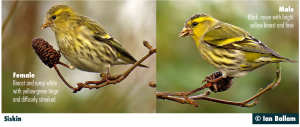
Chaffinch and Brambling are remarkably similar in shape and pattern, with colour details important in separating the two. Both colourful finches, the Brambling has an orange ‘shoulder’ and narrow white rump. Often with Chaffinches, Brambling will feed under trees (Beech often a firm favour), in fields and occasionally beneath bird tables with spilled seed. Chaffinch breed across the harbour, encountered regularly in both urban and rural areas. Large numbers can be viewed during vis-mig watches from South Haven, Ballard and Glebelands. Large winter flocks of up to 300 birds have been recorded at numerous sites including Arne, Swineham and Soldiers Road. On the other hand, Brambling are no longer guaranteed to overwinter as in previous years but remain a regular passage migrant in October and early November. An impressive 300-500 birds overwintered at Arne back in 2003/04!
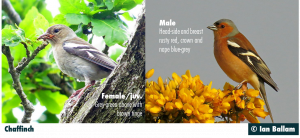
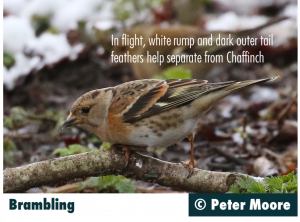
Keep an ear out for the distinctively grumpy ‘nay?’ social calls among the plain ‘yeck’ flight calls of the Brambling, averaging roughly 30% lower than that of the Chaffinch.
The taxonomy of redpolls divides opinion, with some regarding the complex as comprising of several species and others suggesting a lumping of just one, maybe two species. Difficult to tell apart, separation of the various forms is possible, but beyond the scope of this article. Local breeding Lesser Redpoll are by far the most familiar to us in Poole Harbour. October sees birds move away from their breeding grounds and are regularly encountered on ‘vis-mig’. The tiny, tit-like finches are a delight to see up close, with their jet-black bibs and striking red forecrowns. Try search Alder and Birch trees during the winter for birds feeding on the seeds and catkins, with flocks of 50–100 birds often be found at Studland, Arne, Upton Heath and Hartland. However, these flocks are known to wander, not particularly sticking to strict wintering grounds. Listen out for the distinctive harsh ‘che che che’ flight calls, delivered in rapid-fire bursts of two or three notes. Common and Arctic Redpolls are less likely to encounter, but not impossible.
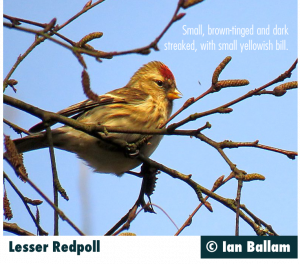
Bullfinch breed across the harbour, favouring areas with thick hedge rows and fruit trees and can be regularly encountered at Upton House, Lytchett Bay, Holton Lee, Studland and Swineham. Movements into more unusual location may also be detected at peak times of passage and is typically a result of local dispersal. However, genuine migration does occur in some years. This was most noticeable in 1987, when a flock of 40-60 birds were recorded at Studland coinciding with an autumn influx of birds into the county the previous October. Other notable historic counts include 30 at Parkstone in December 1974 and 40 at Holton Heath in November 1984. Listen closely for their insignificant-sounding, muted call.
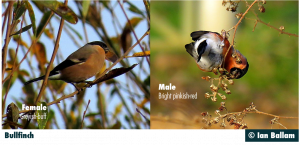
Crossbill numbers around Poole Harbour are very much dependent on invasions. Although the local population (centred around Rempstone heath) is now quite low, irruptions are frequent and can become very common during irruption years. Parties of Crossbill are on the move during August, September and October, and can frequently be observed passing over head any habitat. However, memorising their distinctive flight call is essential to help confirm identification. Once again, Glebelands, South Haven and Ballard are all top sites for witnessing Crossbill on migration. Often heard before they are seen, Crossbills are best located by their powerful, metallic ‘glip’ flight calls.
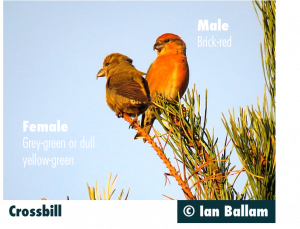
Hawfinch, a highly sought-after migrant locally, are very rare visitors to the harbour, with the best opportunities arising during autumn migration at South Haven, Ballard Down and Glebelands. However, autumn 2017 experienced an unprecedented irruption from southern and eastern Europe, with thousands arrive into the UK. Sightings began in Poole Harbour at the expected coastal locations, however by November they were regularly being seen at inland sites like Lytchett Fields and Lytchett Minster, Arne, Wareham Churchyard and Holmebridge. They even began appearing in suburban gardens in Upton! It’s unknown exactly how many over-wintered during the 2017/18 winter period, but estimates suggest several hundred in Poole Harbour alone and possibly over 1000 across Dorset. Hawfinch calls are far from any other the previous finches discussed, with the ‘vit’ flight calls possessing a Robin-like quality.
